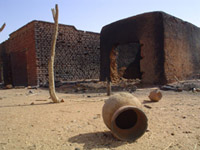 The attacks of 9/11 prompted a decisive shift in U.S. rhetoric towards fragile states. Previously neglected, weak and fragile states were seen as a core development issue and a looming threat to global security. Five years later, what is the U.S. doing to meet this challenge? CGD research fellow Stewart Patrick recently analyzed the U.S. budget to see if the spending matched the rhetoric. He argues in a Q&A that the U.S. has yet to respond with sufficient funding or a coherent strategy.
The attacks of 9/11 prompted a decisive shift in U.S. rhetoric towards fragile states. Previously neglected, weak and fragile states were seen as a core development issue and a looming threat to global security. Five years later, what is the U.S. doing to meet this challenge? CGD research fellow Stewart Patrick recently analyzed the U.S. budget to see if the spending matched the rhetoric. He argues in a Q&A that the U.S. has yet to respond with sufficient funding or a coherent strategy.
Q. What are fragile states and why are they important for international development and U.S. security?
A: Fragile states have trouble performing the most basic functions of any effective state: delivering security to their people, governing legitimately, managing their economies, and providing basic social welfare. As many as 50 countries in the developing world fall into this category. They range from Pakistan, a brittle and chronically unstable nation, to war-torn Liberia, just starting to recover from decades of violence. In some cases fragility is closely linked to poverty. In others like Zimbabwe the big culprit is bad leadership by authoritarian elites. Whatever their origins, fragile states represent both the hard core of today's development challenge and a growing source of transnational threats, ranging from terrorism to crime to infectious disease, as I've argued in a previous working paper, Weak States and Global Threats: Assessing Evidence of Spillovers.
Q. What is the U.S. doing to respond to fragile states?
A: The attacks of 9/11 prompted a decisive shift in U.S. rhetoric toward fragile states. As the president declared at his 2002 National Security Strategy release, "The events of September 11, 2001, taught us that weak states, like Afghanistan, can pose as great a danger to our national interests as strong states. Poverty does not make poor people into terrorists and murderers. Yet poverty, weak institutions, and corruption can make weak states vulnerable to terrorist networks and drug cartels within their borders." But beyond Iraq and Afghanistan, the White House has not yet developed a strategy to deal with fragile states, especially before such countries pose major threats to national security. Nor has it put its money where its mouth is. Our analysis of this year's U.S. budget request shows that, if you subtract aid to Iraq, Afghanistan, and Pakistan -- as well as HIV/AIDS spending -- total U.S. bilateral aid for the world's 50 most vulnerable countries amounts to little more than one dollar per person per year. I hope that the administration's recent foreign aid reorganization will begin to address this gap between rhetoric and reality.
Q. In providing aid to fragile states, how can the U.S. be sure the money is spent effectively and not lost to corruption?
A: There's no question that it's tough to spend aid money effectively in fragile states, particularly where host governments are unresponsive or where corruption is endemic. For this reason donors have tended to focus aid on "good performers," through such mechanisms as the Millennium Challenge Account. But we've also learned that it makes no sense, on humanitarian and national security grounds, to write off an entire class of developing countries. There's growing evidence that carefully targeted aid can help build capacity and commitment for reform in fragile states, which might entail working outside formal government or targeting specific sectors such as education. We recommend that U.S. policymakers treat foreign aid in fragile countries as a form of venture capital -- inherently more risky, but liable to have big payoffs.
Q. How does the U.S. compare to other donor governments working in fragile states?
A: The United States has made some headway. USAID has published its own "fragile states strategy." The State Department has created an office of post-conflict reconstruction. And the foreign aid reform project is meant to promote "effective democratic states" in the developing world. But compared to other donors, the U.S. approach is dominated by security-related concerns, particularly the Department of Defense, at the expense of a government-wide strategy. In contrast, some other donors--notably the United Kingdom--have moved toward a more genuinely "whole of government" approach to fragile states that unites defense, development, and diplomatic actors in a common effort. My colleague Kaysie Brown and I are completing a study on what major donor countries are doing to integrate the "3Ds" (defense, diplomacy and development) in engaging fragile states.
Q. What should be done to improve foreign aid in fragile states?
A: While engaging in fragile states can be risky, it is now clear that abandoning these countries is not the right answer. At the same time, research on "what works" in fragile states is still in its infancy. To increase our knowledge base, CGD has launched a multi-year initiative on Engaging Fragile States, supported in part by the Australian Agency for International Development (AUSAID). We hope to strengthen donor action in fragile states by answering questions such as: What can be done to promote aid effectiveness in the world's weak and failing states? How can external actors help address the endemic problems of corruption in poorly performing countries, particularly in resource-rich countries? And how can donors increase the coherence of their efforts to help prevent state collapse in the first place, rather than being left to pick up the pieces of yet another failed state?

